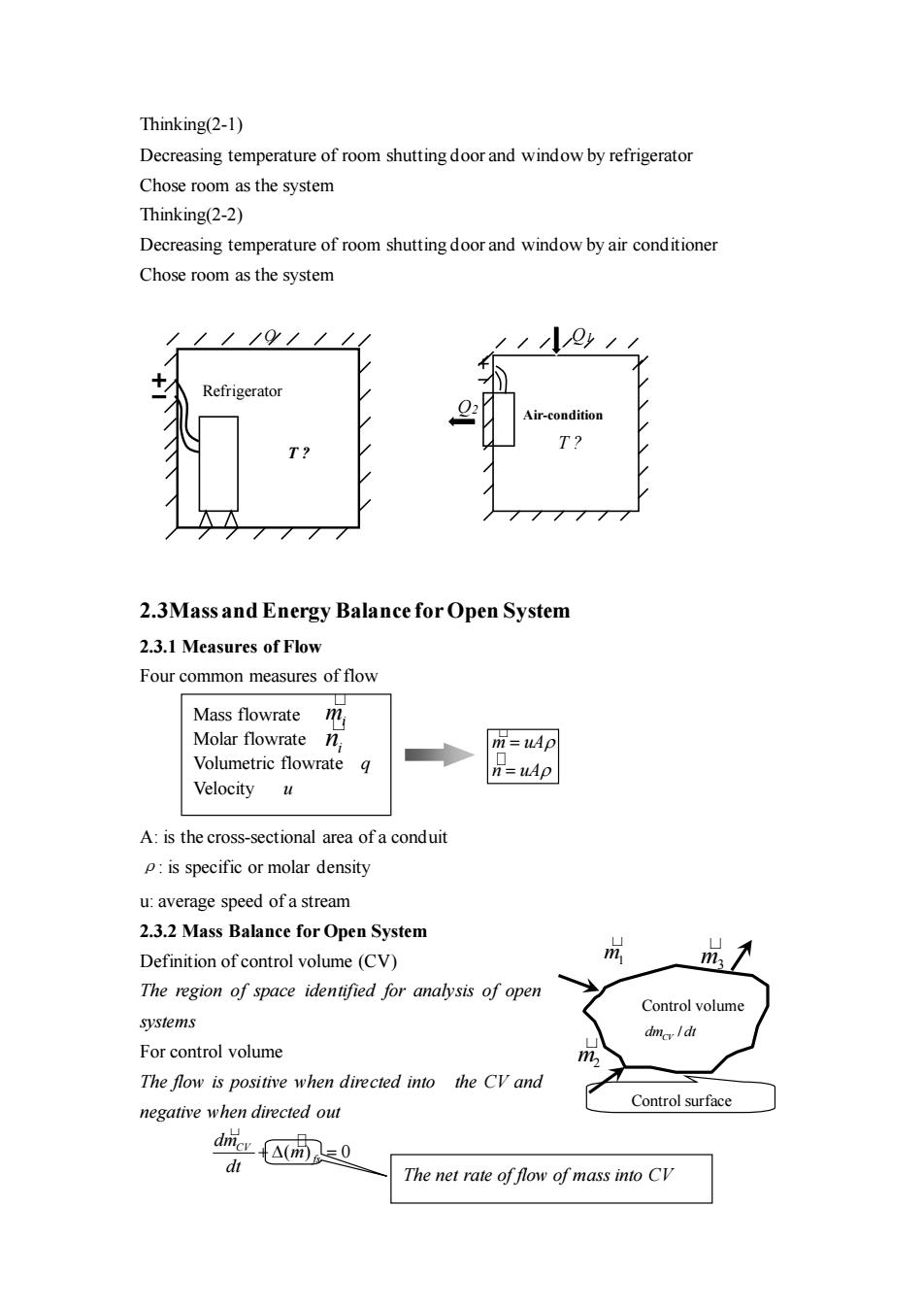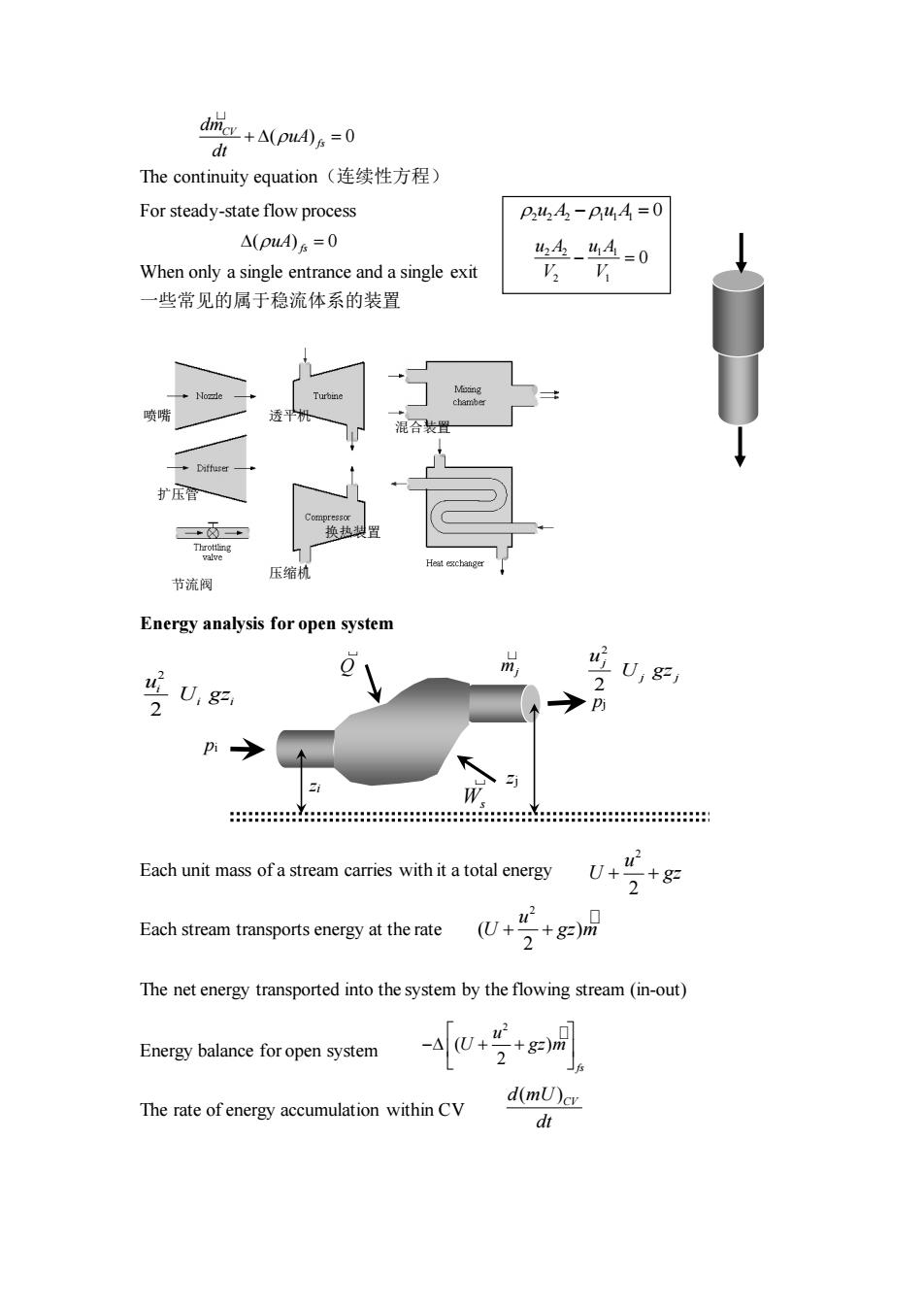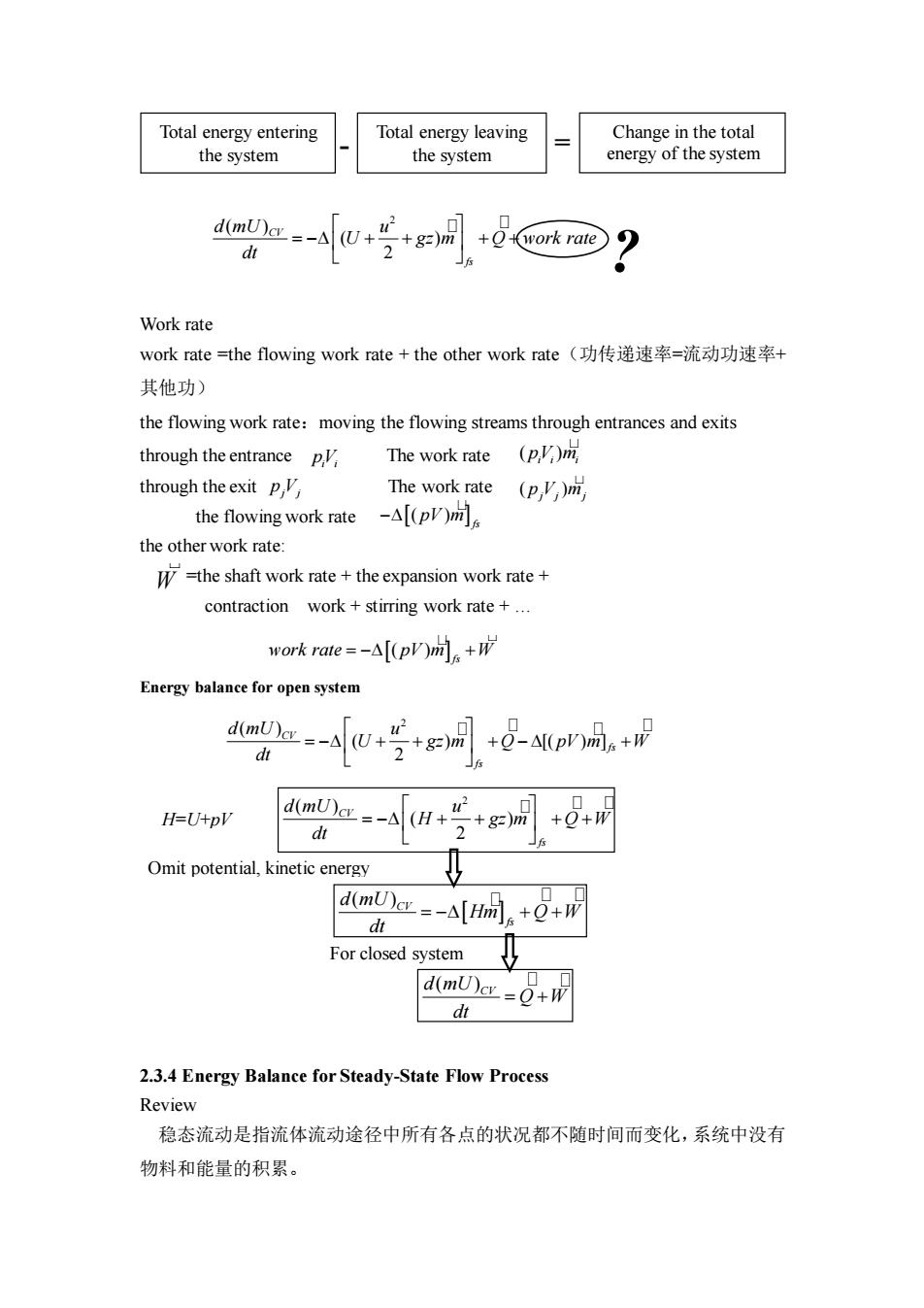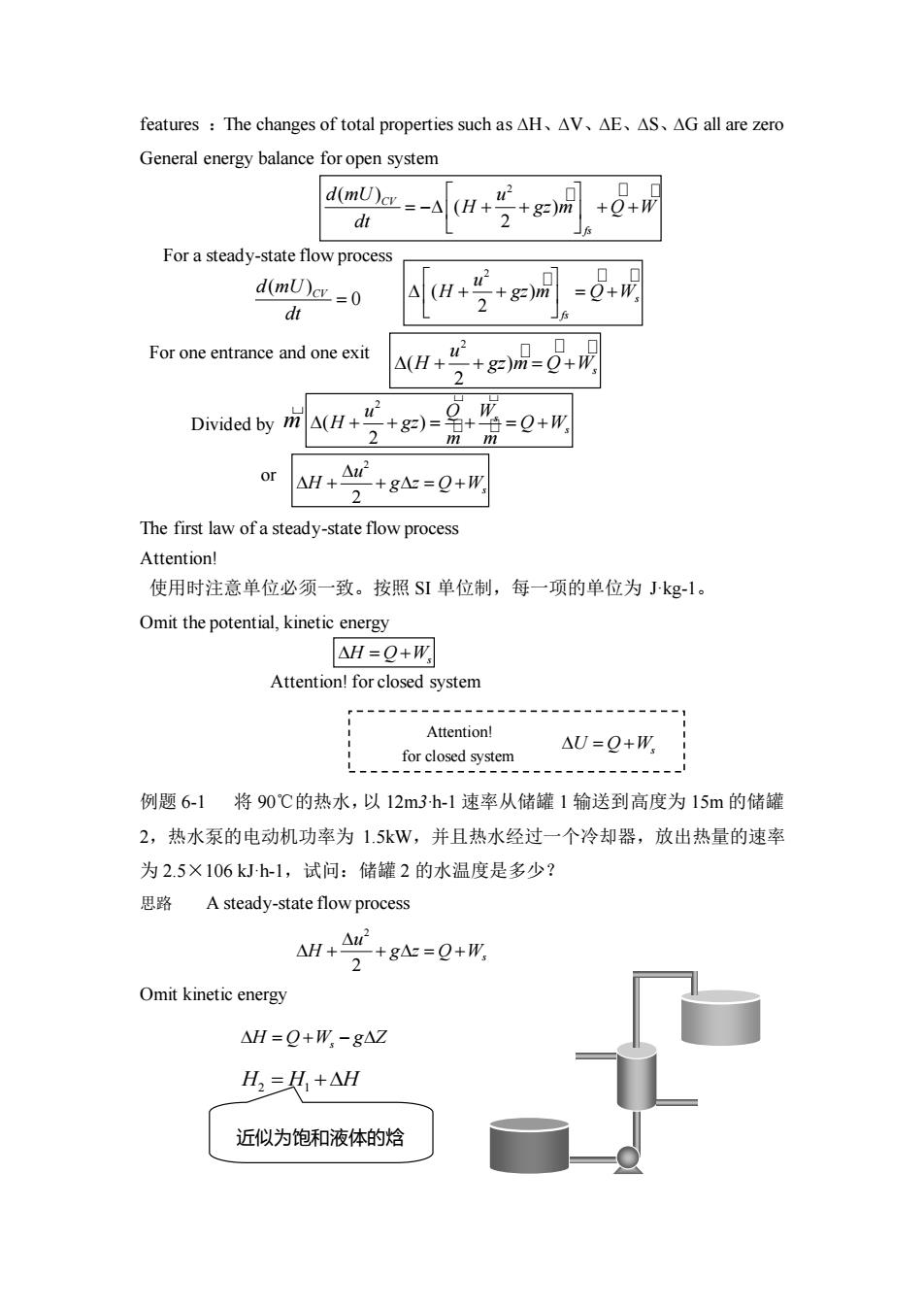
Chapter 2 The First Law and Other Basic Concepts 2.1 The First Law of Thermodynamics 2.2 Energy Balance for Closed System 2.3 Mass and Energy Balance for Open System 2.1 The First Law of Thermodynamics (1)Statement of the first law of thermodynamics Although energy assumes many forms.the total quantity of energy is constant.and when energy disappears in one form it appears simulaneously in other forms (2)The basic form of the first law of thermodynamics: A(Energy of the system)+A(Energy of surroundings)=0 Characteristics of energies (1)Heat and work ()Potential,kinetic,and intemal energy 能量分类: ()系统蓄积的能量,如动能、势能和热力学能,是系统状态的函数。 (2)过程中系统和环境传递的能量,如功、热量,不是状态函数,与过程有关。 2.2 Energy Balance for Closed System Definition of closed system ifthe boundary of a system does not permit the transfer of matter between the system and its surroundings.the system is said to be closed system Energy Balance for Closed System A(Energy of the system)=0+W State That is E=Q+W E2 Energies of a system include System intemal,potential,kinetic energy. surroundings etc. Closed systems often undergo processes that cause no change in the system other than in its intemal energy. 4E=O+W Attention! △U=Q+W O and W,transferring into the system from and du do+dw the surroundings,are positive
Chapter 2 The First Law and Other Basic Concepts 2.1 The First Law of Thermodynamics 2.2 Energy Balance for Closed System 2.3 Mass and Energy Balance for Open System 2.1 The First Law of Thermodynamics (1) Statement of the first law of thermodynamics: Although energy assumes many forms, the total quantity of energy is constant, and when energy disappears in one form it appears simultaneously in other forms. (2) The basic form of the first law of thermodynamics: △( Energy of the system) + △( Energy of surroundings) =0 Characteristics of energies (1) Heat and work (2) Potential, kinetic, and internal energy 能量分类: (1)系统蓄积的能量,如动能、势能和热力学能,是系统状态的函数。 (2)过程中系统和环境传递的能量,如功、热量,不是状态函数,与过程有关。 2.2 Energy Balance for Closed System Definition of closed system if the boundary of a system does not permit the transfer of matter between the system and its surroundings, the system is said to be closed system Energy Balance for Closed System △( Energy of the system) =Q+W That is Energies of a system include internal, potential, kinetic energy, etc. Closed systems often undergo processes that cause no change in the system other than in its internal energy. System surroundings State 2 E2 State 1 E1 Q W E = Q +W Q and W, transferring into the system from the surroundings, are positive Attention! and = + U Q W dU dQ dW = + E = Q +W

Thinking(2-1) Decreasing temperature of room shutting door and window by refrigerator Chose room as the system Thinking(2-2) Decreasing temperature of room shutting door and window by air conditioner Chose room as the system ir-conditio T T 777 2.3Mass and Energy Balance for Open System 2.3.1 Measures of Flow Four common measures of flow Mass flowrate Molar flowrate n m=uAp Volumetric flowrate q n=uAp Velocity u A:is the cross-sectional area ofa conduit p:is specific or molar density u:average speed ofa stream 2.3.2 Mass Balance for Open System Definition of control volume (CV) The region of space identified for analysis of open Control volume systems dmc/dt For control volume The fow is positive when directed into the CV and negative when directed out Control surface dries( d山 The net rate of flow of mass into CV
Thinking(2-1) Decreasing temperature of room shutting door and window by refrigerator Chose room as the system Thinking(2-2) Decreasing temperature of room shutting door and window by air conditioner Chose room as the system 2.3Mass and Energy Balance for Open System 2.3.1 Measures of Flow Four common measures of flow A: is the cross-sectional area of a conduit ρ: is specific or molar density u: average speed of a stream 2.3.2 Mass Balance for Open System Definition of control volume (CV) The region of space identified for analysis of open systems For control volume The flow is positive when directed into the CV and negative when directed out Mass flowrate Molar flowrate Volumetric flowrate q Velocity u mi i n m uA n uA = = Q2 Air-condition Q1 T ? ( ) 0 CV fs dm m dt + = Control volume Control surface m3 m2 m1 / dm dt CV Q T ? Refrigerator The net rate of flow of mass into CV

d城+A(pu0a=0 The continuity equation(连续性方程) For steady-state flow process P44,-P44=0 △(pu4)6=0 h4-44=0 When only a single entrance and a single exit 一些常见的属于稳流体系的装置 扩压 节流阀 压缩材 Energy analysis for open system m U,g= 0 U,g=, 2 Each unit mass of a stream carries with it a total energy 2+& Each stream transports energy at the rate U+ 2+8 The net energy transported into the system by the flowing stream(in-out) Energy balance for open system The rate of energy accumulation within CV d(mU)cv dt
The continuity equation(连续性方程) For steady-state flow process When only a single entrance and a single exit 一些常见的属于稳流体系的装置 Energy analysis for open system Each unit mass of a stream carries with it a total energy Each stream transports energy at the rate The net energy transported into the system by the flowing stream (in-out) Energy balance for open system The rate of energy accumulation within CV zi 2 2 i i i u U gz zj mj 2 2 j j j u U gz Ws Q pi pj ( ) 0 CV fs dm uA dt + = = ( ) 0 uA fs 2 2 2 1 1 1 u A u A − = 0 2 2 1 1 2 1 0 u A u A V V − = 换热装置 压缩机 喷嘴 扩压管 透平机 混合装置 节流阀 2 2 u U gz + + 2 ( ) 2 u U gz m + + 2 ( ) 2 fs u U gz m − + + ( ) d mU CV dt

Total energy entering Total energy leaving Change in the total the system the system energy of the system d(mU)cr_ -A +ork rate Work rate work rate=the flowing work rate+the other work rate(功传递速率=流动功速率+ 其他功) the flowing work rate:moving the flowing streams through entrances and exits through the entrance p The work rate (pm through the exit p,V The work rate (p,v)m the flowing work rate -A[(pV] the other work rate: =the shaft work rate+the expansion work rate+ contraction work+stirring work rate+. work rate=-A[(plm。+W Energy balance for open system =-[+片+g+-pn+ H=U+pV m-4+号g调+0+ d Omit potential,kinetic energy ma=-A。++ For closed system d(mU)cr dt =0+ 2.3.4 Energy Balance for Steady-State Flow Process Review 稳态流动是指流体流动途径中所有各点的状况都不随时间而变化,系统中没有 物料和能量的积累
Work rate work rate =the flowing work rate + the other work rate(功传递速率=流动功速率+ 其他功) the flowing work rate:moving the flowing streams through entrances and exits through the entrance The work rate through the exit The work rate the flowing work rate the other work rate: =the shaft work rate + the expansion work rate + contraction work + stirring work rate + . Energy balance for open system 2.3.4 Energy Balance for Steady-State Flow Process Review 稳态流动是指流体流动途径中所有各点的状况都不随时间而变化,系统中没有 物料和能量的积累。 H=U+pV 2 ( ) ( ) 2 CV fs d mU u H gz m Q W dt = − + + + + Omit potential, kinetic energy ( )CV fs d mU Hm Q W dt = − + + For closed system ( ) d mU CV Q W dt = + 2 ( ) ( ) 2 CV fs d mU u U gz m Q work rate dt = − + + + + ? Total energy entering the system Total energy leaving the system Change in the total energy of the system - = ( ) pV m i i i pVi i ( ) j j j p V m pVj j ( ) fs − pV m W ( ) fs work rate pV m W = − + 2 ( ) ( ) [( ) ] 2 CV fs fs d mU u U gz m Q pV m W dt = − + + + − +

features:The changes of total properties such as AH、AV、△E、AS、△Gall are zero General energy balance for open system am-ah+号+g+ dt For a steady-state flow process d(mUc=0 4(H+ +=0+ dt For one entrance and one exit +gn品-0+ 4(H+4 Divided by(H +)=名 游=0+形 or 4H+4r +g△=Q+W The first law of a steady-state flow process Attention! 使用时注意单位必须一致。按照S单位制,每一项的单位为kg1。 Omit the potential,kinetic energy △H=Q+W Attention!for closed system Attention! for closed system 0-0 例题6-1将90℃的热水,以12m3h-1速率从储罐1输送到高度为15m的储罐 2,热水泵的电动机功率为1.5kW,并且热水经过一个冷却器,放出热量的速率 为2.5×106kJh-1,试问:储罐2的水温度是多少? 思路 A steady-state flow process ANH+A+g4=Q+形 2 Omit kinetic energy △H=Q+W,-gA☑ H,=其+AH 近似为饱和液体的焓
features :The changes of total properties such as ∆H、∆V、∆E、∆S、∆G all are zero General energy balance for open system The first law of a steady-state flow process Attention! 使用时注意单位必须一致。按照 SI 单位制,每一项的单位为 J·kg-1。 Omit the potential, kinetic energy Attention! for closed system 例题 6-1 将 90℃的热水,以 12m3·h-1 速率从储罐 1 输送到高度为 15m 的储罐 2,热水泵的电动机功率为 1.5kW,并且热水经过一个冷却器,放出热量的速率 为 2.5×106 kJ·h-1,试问:储罐 2 的水温度是多少? 思路 A steady-state flow process Omit kinetic energy For one entrance and one exit For a steady-state flow process ( ) 0 d mU CV dt = 2 ( ) 2 s fs u H gz m Q W + + = + 2 ( ) 2 s u + + = + H gz m Q W Divided by m 2 ( ) 2 s s u Q W H gz Q W m m + + = + = + 2 ( ) ( ) 2 CV fs d mU u H gz m Q W dt = − + + + + 2 2 s u H g z Q W + + = + or = + H Q Ws Attention! for closed system = + U Q Ws 2 2 s u H g z Q W + + = + = + − H Q W g Z s H H H 2 1 = + 近似为饱和液体的焓